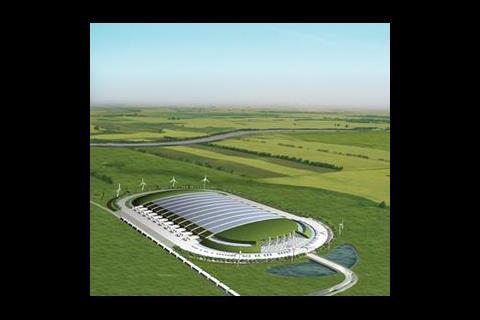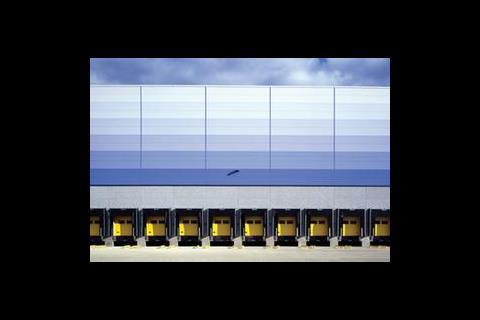The Eco Template initiative is set to revolutionise distribution centre design over the next 10 years, but could the humble shed really become a habitat, power generator and zero carbon emission development? Andy Pearson takes stock of these new models
Distribution sheds: nobody could say they're at the cutting edge of architecture. But what will they look like in 10 year's time?
Architect Chetwood has been working with environmental consultant William McDonough, M&E consultants King Shaw Associates and Kelly Taylor Associates and logistics property developers Gazeley Properties to establish this. The mission: to investigate how a distribution building can deliver 25% reductions in CO2 emissions, 25% energy savings and 75% savings in water used over the next 10 years.
Doug King, founding partner of King Shaw Associates, says the project was set up to see what could be done to make distribution sheds more efficient and more acceptable to planners. He says their design, and the rationale for many decisions, had evolved over years and "the idea of questioning the way everything in shed design was being done was radical".
The solution is the "Eco Template": a series of three models of distribution sheds incorporating increasing levels of sustainable technologies, launched in October 2004.
Bedford's Marsh Leyes scheme was constructed to level one standard, which is designed to use the technologies that are currently cost effective. This scheme will save 156 tonnes of C02 a year and reduce office water requirements by 45%. According to Gazeley, it cost just 50 pence more per square foot to build than conventional buildings.
Level 2, the "optimised design", will include more advanced environmental technologies that together reduce the power requirements to the building by 15% and save 378 tonnes of C02 a year. This scheme is expected to be cost effective within the next year or two.
Finally, there is the revolutionised design. This will include all the latest materials and energy-saving techniques and is a vision of how distribution buildings might evolve over the next 10 years (see above). The designers' vision is ultimately for it to become a habitat, a power generator and zero carbon emission development.
"The study shows that an environmentally friendly sustainable agenda can be implemented over time. This allows clients to set in place measures that will benefit them, and the environment, without compromising their position in the marketplace," says Laurie Chetwood, founder of architect Chetwood.
Gazeley has used the study to establish a road map, setting goals for the future to deliver continued environmental improvements throughout their European property portfolio. In December 2005, the company's first German Eco-Template logistics building was completed.
The German scheme in Wiesbaden included many of the features found in the Marsh Leyes scheme in Bedford, but with the addition of a 10,000 m2 green or "living" roof to help protect the warehouse against high summer temperatures. "In order to minimise our dependency on imported energy, we have to focus on renewable sources," says Terry Chung, development director of Gazeley Germany.
The firm's next big scheme in Germany, currently under construction, will incorporate one of the biggest roof photovoltaic systems in Europe for Wal-Mart's chilled distribution centre at Bingen am Rhein. The 16,000 m2 roof is claimed to improve the energy balance of the distribution centre by 50% per annum, or an equivalent of nearly 300 tonnes of C02. The building also incorporates solar collectors to provide hot water for the offices.
In the UK, Gazeley is working on Voltaic, a 22,000 m2 warehouse development at Dagenham Dock, Essex. The £27m facility incorporates a suite of 12 EcoTemplate elements, designed to prevent 102.5 tonnes of CO2 entering the atmosphere each year. The scheme includes:
• Solar photovoltaic roof panels to generate electricity, saving 5 tonnes of C02
• Roof lights to cover 15% of the roof providing natural light, saving 54 tonnes of C02
• Ground source heat pumps for heating and cooling, saving 40 tonnes of C02
• Cycle store with solar lighting canopy, saving 2 tonnes of C02
• Solar water heating, saving 2 tonnes of C02
Commercially, the Eco Template initiative makes sense for Gazeley, with developers facing more stringent environmental legislation and planning restrictions (including the Energy Performance of Buildings Directive), while potential tenants often have strict corporate social responsibility targets to meet. n
Getting to 10%: a BSj seminar

Local government is using planning powers to ensure developments use more renewable energy on their projects. In London, the GLA is looking for all major new developments to incorporate a proportion of renewable energy. And developers are turning to their design team to help them meet their corporate environmental initiatives.
Architects, engineers and installers have to be able to help their clients to meet these targets cost effectively. Are you ready?
On 26 April, the BSJ Seminar “Getting to 10%” will show delegates how they can design, use and manage renewable energy in buildings. Speakers include Eddie Taylor of Croydon Borough Council, who will explain what local councils are looking to designers to provide; Simon Burton of Faber Maunsell, who wrote the GLA’s Renewables Toolkit and is working with planners on assessing the renewable contribution; and Peter Sutcliffe, MD of CameronTaylor who will be sharing his experience of designing buildings to meet the 10% target.
Delegates will be able to hear practical advice about what planners expect designers to include in a scheme, including heat pumps, wind, ground-coupled systems and solar systems. Leading experts will explain how the technologies can be made to work on a project.
Renewable energy is no longer confined to one-off projects. It has become part of commercial and domestic projects across the UK. Make sure your knowledge is up to date and register today.
- The event takes place on 26 April at the Institution of Mechanical Engineers, 1 Birdcage Walk, Westminster, London SW1H 9JJ.
- Cost: £150 + VAT for a single delegate or £380 + VAT for 3 delegates.
- To book, contact Marilyn Dent on 020 7560 4193, email mdent@cmpinformation.com or visit www.bsjonline.co.uk
Downloads
The 2010 distribution shed
Other, Size 0 kb
Source
Building Sustainable Design
























No comments yet